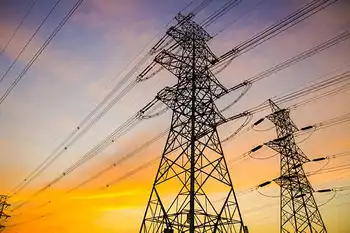Wyoming Bill Would All But Outlaw Clean Energy by Preventing Utilities from Using It
Protective Relay Training - Basic
Our customized live online or in‑person group training can be delivered to your staff at your location.

- Live Online
- 12 hours Instructor-led
- Group Training Available
Wyoming Anti-Renewable Energy Bill proposes banning utility-scale wind and solar for in-state electricity, favoring coal and gas, imposing fines on utilities, and reshaping energy policy, rates, and climate goals statewide.
Key Points
A Wyoming bill to ban utility-scale wind and solar in-state, prefer coal and gas, and penalize utilities.
✅ Bans utility-scale wind and solar for in-state electricity
✅ Prioritizes coal, gas; excludes large renewable projects
✅ Imposes $10/MWh penalties on non-eligible power
Coal supporters are pushing a bill that would bar utilities from using the state's abundant wind power to provide electricity within the state.
While many U.S. states have state renewable policies and incentives to get more of their electricity from renewable energy, Republican legislators in Wyoming are proposing to cut the state off from its most abundant, clean resource—wind—and ensuring its continued dependence on coal.
A new measure submitted to the Wyoming legislature this week would forbid utilities from providing any electricity to the state that comes from large-scale wind or solar energy projects by 2019. It's an unprecedented attack on clean energy in Wyoming, and possibly the nation. And it comes at a time when such resources are becoming cheaper and increasingly in demand as the world seeks to transition to clean energy to prevent the worst impacts of climate change.
The bill's nine sponsors, two state senators and seven representatives, largely come from Wyoming's top coal-producing counties and include some deniers of man-made climate change. They filed the bill on Tuesday, the first day of the state's 2017 legislative session. Activists and energy experts are alarmed by the measure, which would levy steep fines on utilities that continue providing (or provide new) "non-eligible" clean energy for the state's electricity, even as some utilities try to tilt the solar market in other states as well. But they are skeptical it will get enough support to become law.
"I haven't seen anything like this before," Shannon Anderson, director of the local organizing group Powder River Basin Resource Council, told InsideClimate News. "This is essentially a reverse renewable energy standard."
Anderson, who has tracked the Wyoming legislature's work for a decade, added: "I think there will be a lot of concerns about its workability and whether this is something the state needs to do... it seems to be 'talking-point' legislation at this point."
Last year, Republican Gov. Matt Mead introduced a new energy plan for the state that involved "doubling down" on coal. But even this fossil fuel-centric plan included room for the state's renewable resources, especially wind energy, to grow.
The new bill mandates utilities to use "eligible resources" to meet 95 percent of the state's electricity needs in 2018 and then all of its power supply in 2019. Those sources are defined as coal, hydroelectric, natural gas, net metering sources (such as rooftop solar, where rooftop solar caps are being debated, or backyard wind projects for homeowners and small business), nuclear and oil. Using power from utility-scale wind, solar and other renewable projects would be outlawed under this legislation.
Wyoming generates and consumes mostly coal-powered electricity, even amid talk of an end to the 'war on coal' nationally. Nearly 90 percent of electricity generated in the state came from coal in September 2016, the latest month with available data. Renewables, mainly wind, were the second-biggest source; other small sources of electricity included petroleum- and natural gas-powered plants and hydroelectric power.
A big state with vast energy resources and a small population, Wyoming produces a lot more power than it needs: It is the nation's largest producer of coal, fourth-largest natural gas producer and eighth-biggest crude oil producer, according to the U.S. Energy Information Agency. Wyoming also ranks high in untapped wind resources, with one of the nation's largest wind farms under construction. The wind power expected to be generated at this massive project, however, along with much of the wind power already being produced in the state, is already destined for out-of-state markets.
Under this new proposal, power providers could continue to generate and sell wind to customers outside of Wyoming without a penalty—but they would be hit with a fee for providing that same power to in-state residents and businesses. Utilities that fail to meet the proposed standards would face $10 penalty for each megawatt hour of energy the utility fails to procure from approved sources and the utility couldn't recover this penalty by raising customer rates, amid concerns over federal electricity pricing changes now being debated.
Pacific Corp.'s Rocky Mountain Power and Black Hills Corp.'s Black Hills Energy are among the utilities operating in Wyoming that could feel the bill's impact because some of the electricity they provide to the state comes from clean energy sources now. Spokespeople from both companies told InsideClimate they are still reviewing the bill and wouldn't comment further.
When asked about the motivation for the bill and concerns about it driving away future wind generation, bill sponsor Republican Rep. David Millerfrom Fremont County said, "Wyoming is a great wind state and we produce a lot of wind energy. We also produce a lot of conventional energy, many times our needs. The electricity generated by coal is amongst the least expensive in the country. We want Wyoming residences to benefit from this inexpensive electrical generation."
"We do not want to be averaged into the other states that require a certain [percentage] of more expensive renewable energy," Miller wrote in an email to InsideClimate News.
(In Wyoming, wind and natural gas are the cheapest forms of new energy generation, according to Dave Eskelsen, a spokesman for Rocky Mountain Power.)
Some of the bill's sponsors are also vocally opposed to climate action and continue to openly question the scientific consensus on climate change.
"The controversy of climate change affects our families in Campbell County," writes state Rep. Scott Clem on his website. "Coal=Jobs. The fact of the matter is that man-made climate change is not settled science. Instead, it is hotly disputed by reputable and educated men and women...."
Although Republicans outnumber Democrats 51-9 in the state House and 27-3 in its Senate, Miller, the sponsor, isn't confident the bill will pass. He estimates its chances are "50 percent or less."
"It's a clear statement the legislature is supporting the traditional sectors of the economy," said Robert Godby, director of University of Wyoming's Center for Energy Economics and Public Policy. Regardless of whether this bill passes, he added, "the fact that it has been run up the flagpole might have some negative consequences." For example, wind developers may be less interested in operating in the state.
Another recently proposed state bill seeks to increase the state's tax on wind generation, a move that could also potentially discourage future wind projects as well.















